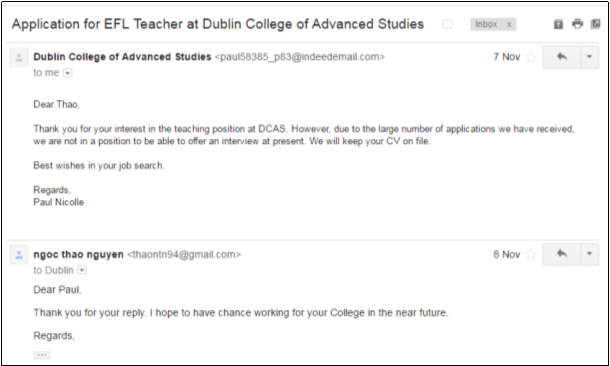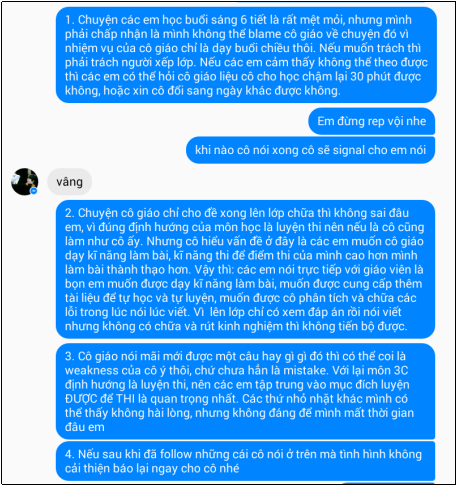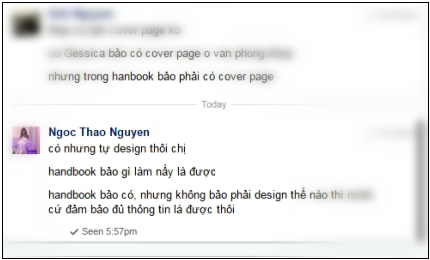Investigation: Personal Technology Mediated Communication
Table of Contents
2.1.7Intertextuality – Retrievability – Navigability
2.1.9Lack of desire for self-disclosure
2.3.1Numbering, paragraphing, colouring – textual specification
2.4Interweaving of media in extended interactions
2.4.5Instant feature and directive influence
|
FtF |
face-to-face |
|
FB |
|
|
FM |
Facebook Messenger |
Communication in today’s world is profoundly affected by technological features and user’s perceived of their usage. Multimodal technological resources facilitate interaction beyond temporal and spatial distance with various participation modes (Barton & Lee, 2013, p. 29), also correlate with users’ medium choice, behaviour and psychology.
In technology-mediated communication, choice of mode is decided by the setting, selecting strategy and evaluating outcome of the communication (Joinson, 2003, p. 125), or by participants’ perceived affordances of the media (Herring & Demarest, 2011, pp. 19-21). For instance, text can be preferred over more novel medium like audio or video thanks to its richer communication markers, asynchronicity and low level of self-consciousness. In a paper by Laursen (2012, pp. 87-97), the shift from text message to call is attributed to synchronicity, immediacy, complex information processing, and chance for negotiation. Call also denotes some degree of intimacy involving simultaneous checking of relationship status through breath, pitch or pauses in oral exchange.
Innovation in communication technology also entails more types of semiosis for interaction. Hutchby (2001, p. 96) points out telephone conversation has a distinct means of summon not by human oral production but by the sound of the ring which signals an upcoming call that the other end of the line will pick up and respond. Later when Internet appears, it enables greater access to information thanks to intertextual hyperlinks or expression of emotions via emoticons (Barton & Lee, 2013, p. 29). Added to this, (Lamy, 2006, p. 388) lists clicking a button to denote “conversation ended”, retaining of message after the interactants have left the chat platform, also the help of telepresence indicators like the faded name or photo. Vandergriff (2013, pp. 8-10) focuses on the use of CMC cues in which the use of multiple exclamation mark could express assertiveness or intensified disagreement, smiley icons indicate a dispreference of an action, or turn ellipsis is understood as mitigated disapproval or openness for conversation expansion.
Additionally, technology also influences our language and our self-expression. Hutchby (2001, p. 86) concerns the lack of physical context cue that makes telephone conversations normally involve identification process at the beginning of the conversation. In online language analysis, Barton and Lee (2013, p. 69) and Herring and Demarest (2011, p. 4) mention gender in which male users tend use more impersonal expression and longer messages whereas female prefer to use the first person and express more feelings. Moreover, Barton and Lee (2013: 68-69) claim that the dynamics and control over our online self-disclosure involve choosing which part of and how our identities to be revealed and accordingly present a less or more associative image in comparison to our offline identities. This regulates our online writing language and entails adjustment of language to whom we could expected or imagined.
Regarding behaviour and psychology, Joinson (2003) proposes five key dimensions of tool-behaviour relationship involves synchronicity, the cues transmitted, bandwidth and cost constraints, level of anonymity, and sender-recipient exclusivity. In CMC, people may also tend to follow the hyperpersonal model (Walther et al., 2015, pp. 13-14) whereby they exaggerate perceived reality about the other interactants and use it to inform their future actions. Device’s affordances may cause users to be under “pressure to be constantly available” for being contacted (Cumiskey & Ling, 2015, p. 231). Also, online psychology and behaviour involves individual self-disclosure where people desire to express themselves (Walther et al., 2015) and act as the source of information (Sundair et al., 2015), whereas includes deindividuation in which individual identity is partially or fully hidden (Walther et al., 2015, p.11) or self-awareness is reduced to merge in online social norms (Spears & Postmes, 2015, p. 25).
In a nutshell, a number of aspects related to technology-mediated communication have been investigated and is being studied in response to the rapid development of technological applications and diverse users’ perceived affordances. The following part, hence, will dedicate to analyse my own use of technology for communication in the light of the reviewed studies, and hopefully brings out some contributive findings.
Devices involved in this analysis were tablet, mobile phone and computer, and the tablet also has a SIM card reader so it can act as a mobile phone. Soft medium analysed included Google Email and online data cloud, Facebook (FB), Facebook Messenger (FM) – a separate application for sending messaging or calling among FB users, and Skype – another application for sending text messages and making calls. All these applications are Internet-based and free of charge.
2.1 Choice of mode
2.1.1 Cost
Cost is the first-and-foremost factor that manipulates my communication mode choice. The more the medium costs, the less likely it is to be chosen. Though the SIM card enabling domestic and international calls, mobile phone was not favoured since phone service always charged money and the fee would be burgeoned for overseas interaction. Consequently, I only employed free services like email to contact professors or Skype and FB to contact relatives and friends though all of them are approachable on telephone line. I once used mobile phone to contact an overseas travel agency in the US because their line was toll-free, so I only had to pay a minimal amount of money for international dialling but I could talk on the phone as long as I want since the call fee was paid by the travel agency.
2.1.2 Degree of comfort
Thanks to its light weight mobility and availability, Tablet was more preferred with higher comfort degree over computer with heavier weight and requiring more acts like starting, shutting down or plugging charger. Tablet was more mobile to carry along to all places such as desk, bed, classroom and in motion like walking on the street. The degree of comfort was also true to the choice of soft medium where none of my communication involved video sharing or video calling. This is explained by my preference for modes with low level of self-consciousness like texting or calling where I could comfortably maintain interaction without being distracted by my reflection or worrying about my appearance on the screen.
2.1.3 Medium uniqueness
Choice of mode was restrained by the other entity and this made me stick to only one medium. For instance, brands’ or organizations’ websites all offer visitors to leave their emails so that new reduction/sales or upcoming events would be sent to them automatically, and the sole medium used to subscribe was email. In another case of citizen services, when I wanted to book a visa appointment via an Embassy, the office only allowed booking via mobile phone in which visitors dial the provided number to provide personal information and receive confirmed schedule by an officer. Besides, some of my addressees only provide me their email or their FB so email or FM were the sole channels to communicate with them and no other choice of medium could be employed.
2.1.4 Formality
Formality of the message and the interaction itself also decides the modes of communication. For formal communication like asking for professor’s supervision, excusing absence in a class session or job application, email would be a better choice. The email interface itself is more neutral and professional with separate spaces for typing subjects and contents, office font sizes, bullet and numbering, etc. to present the information in a well-organized and formal format. Those functions are not provided by the instant messaging, mobile phone SMS or calling. For informal talks like gossiping about non-academic problems, email may not be as suitable as other texting or chatting applications that allow instant response.
2.1.5 Peer influence
The medium I choose was also affected by the technology that the other entities use. If the addressees encounter some technical or personal problems, I accordingly opt for the medium that best works on their device and suit their condition. For example, my mother’s eyes are far-sighted so it’s hard for her to navigate where to click to see inbox or to send text in emailing and texting. For that reason, I only used voice chatting or video calling rather than texting when communicating with her. My father, more interestingly, does not know how to use any “smart” devices and could only be approached by classic media like SMS or phone calling, so whenever I wanted to contact him phone-calling is my only resort.
2.1.6 Immediacy
Regarding the immediacy in communication, email seems to be inferior to other applications like mobile phone, Skype or FM. Email could take long duration to receive a response and they are at risk of being filtered as “spam” or “junk” by the email account. If the recipient does not check their spam box, there is likelihood that my email never reaches them. There is also another case when sending emails to organizations/offices and my email is not instantly checked and replied until the next day because it has to “queue” in a line of many other enquiries sent to the offices. And of course it is very awkward and time-consuming when having an informal and close-knit chat with friends in which me and my friends keep clicking and sending emails while we can choose to text each other using FM or Skype. Therefore, in case I need an immediate response for my communication, I prefer calling via mobile phone (if the information is urgent) or Skype or texting with FM.
2.1.7 Intertextuality – Retrievability – Navigability
Obviously, text mode normally allows better information retrieval than call mode, and this function is more enhanced in CMC where external sources of information exchanged in interaction could be accessed by all interactants and be easily navigated with one click even when the conversation has ended. For example, functions incorporated in Google email enables searching sent or received mails through typing keywords and provides capacity to upload audio, video and documents easily shared with other people who have Google account just by one click. Or in another case when I had a group chat discussing accommodation booking, we decided to type because it was easier to refer to different options by pasting the links or screen captures into the chatting box and the whole group could see exactly which hostel was being considered. Those options were retained forever in the box chat so we could retrieve them several days/months later.
2.1.8 Multifunction
Sometimes the consideration of hard medium between computer or Tablet is decided by the affordances of the device itself, and it is obscure that computer is more multifunctional than the other counterpart. Computer allows multi-window operating at the same time while my Tablet does not, also many acts are easier to be done on bigger screen and keyboards rather than on touch device, e.g long text processing. Multifunctional features also applied for my choice of soft medium and this could be illustrated in the comparison between email and IM via FM or Skype. Email’s affordances are superior with possibility to forward a large amount of information, to format the text in highlighted forms with colouring, large font size, or underlining, or to send emails to different recipients simultaneously without letting them know about each other (Bcc). FM or Skype undeniably has not included all those functions, they do not have a search box to type in keywords, no data cloud, no font size or bullet options, and previous messages are time-consuming to retrieve. However, their function to track whether the recipient has seen their messages made them surpass email in some cases.
2.1.9 Lack of desire for self-disclosure
My choice of medium, or to be exact, the functions of medium was affected by my low desire for self-expression in which I use FB but hardly employed multimodal resources for posting, sharing, surfing, hashtag, or commenting. I have little demand for self-disclosure so I did not share the things I read, the feelings I have or the events/places I had been to on my FB page. All my interactions via FB channel were instant messaging initiated by the need to update situation of relatives and friends in my home country or exchange information about a particular problem. Even though I am a member of some FB group, I still sent private message to other members when they post a question that I can help instead of publicly typing my answer in the comment box.
2.2 Nature of language used
2.2.1 Language background
The majority of my interaction with friends or relatives is translingual since we have multilingual background. Our exchange has frequent code-switching between Vietnamese and English, or in some cases three languages when I use Thai to chat with friends who know Thai. An ample evidence for this could be seen in the following extract between me and other two friends discussing about booking a room for a cruise trip (English words are highlighted in the left column):
|
the thoi xong chac cho ten + passport de dang ky la xong in the worst case thì phòng 8107 cÅ©ng được ha uhh worst case cung dc re nhung tren web con nhieu lam, hon chuc phong co, ko lo Thế là chốt xog Ä‘úng hok Chốt lại bn ng 4 ng mail sent TrÆ°a mai chÆ°a rep thì e gá»i Ä‘iện cho ổng luôn |
that’s all then perhaps we give (him) our names and passport to register in the worst case, is room 8107 OK? Yes, that worst case is OK. cheap But don’t worry, the web stills show a lot of spare rooms, more than ten of them. That’s finalized right? In the end how many people? 4 people mail sent If he does not rep the mail until next noon, I will call him. |
2.2.2 Keyboard affordance
Languages involved in my conversations are used in customized form due to keyboard. For instance, some of my Vietnamese friends did not have keyboard allowing typing tone markers or special Vietnamese characters, so their message were written in reduced Vietnamese. Though in some rare occasion did this obstruct our communication, the conversation generally went smooth because all interactants have Vietnamese as mother-tounge. Take the message from the following extract as an illustration, the friend that customized language is Anh:
|
Original message |
Standard language |
Translated message |
|
the thoi xong chac cho ten + passport de dang ky la xong |
thế thôi xong chắc cho tên + passport để đăng ký là xong |
that’s all then perhaps we give (him) our names and passport to register |
Also due to keyboard’s lacking special characters, some language not using Latin alphabet must be transliterated and in my case is Thai. There was Thai virtual keyboard but it took time and may impede understanding so it was not employed:
|
Original message |
Standard language |
Translated message |
Uh hihi tks quân nhìu
May pên ray krub |
Uh hihi tks quân nhìu
ไม่เป็นไรครับ |
Yeah hihi thanks a lot
You’re welcome! |
2.2.3 Intimacy level
Intimacy is the key factor shaping the choice of language in all my communications, and the level of formality in language is accordingly adjusted. Informal language could be detected via the use and density of colloquial, emoji, stickers, slangs, swear words. When talking with close friends, I used these informal expressions uncontrollably or rampantly, but I was more conscious and limit the use of them when interacting with normal friends, which are exemplified in the following extracts:
Extract 1: with close friends (me, Trung and Ngoc). Ngoc is talking about her disgust when coming across her ex-boyfriend’s photos on Facebook. The language is flooded with swear word, exclamation, emoji, emphatic form like capitalisation and repetition of letters:
mày có câu thần chú gì k má»-i lần lạnh gáy thì lẩm nhẩm
đợt trc Ä‘ã block hết tất cả má»i thứ má»i ngÆ°á»i thồi thế Ä‘ nào vẫn sót ối giợi Æ¡i có hôm thế nào xem Ä‘c dm cả nó cả ny má»›i dm Ä‘i phượt ôi
m phải hiểu là cái nhóm bạn lìn của nó chuyên Ä‘i phượt và chụp ảnh và ăn lẩu và chụp ảnh (net uốc king) nên dm nhiá»u ảnh vc ra????? CỨU TÔI VỚI :((((((((((((((((((((((((((((((((( |
Do you have any incantation whenever feeling disgusted?
I blocked all things and all people related to him but I still missed out some photos Oh my god Fuck it the other day I saw he and his new girlfriend fucking went trekking. oh
U have to understand that his fucking group of friends frequently go trekking and take photos and eat hotpot and take photos (networking) So there’s a fucking bunch of photos????? HELP ME :((((((((((((((((((((((((((((((((( |
With a normal friend. This is Doan – one friend I have acquainted for about 3 months, she is talking about her travel plan for Christmas. The relationship is not too close-knit hence the language is informal enough with the use of emoji but no swear words or emphatic forms:
tụi tá»› xmas này Ä‘c nghỉ dài Ä‘i 1 phát luôn
uh bá»n tá»› cÅ©ng nghỉ dài nhÆ°ng tá»› cÅ©ng không ham Ä‘i lắm
^^ uh
các bạn Ä‘i khu nào tây âu hay Ä‘ông âu
tá»› Ä‘i Ä‘ông âu, tây âu và nam âu
5 nÆ°á»›c 1 tháng luôn
má»-i nÆ°á»›c ở 6 ngày?
uh
thấy anh việt đăng xin được visa phần lan thế là Ä‘i phần lan trÆ°á»›c à
anh việt Ä‘i finland 1 mình mà =)) |
This Xmas we have a long holiday. We travel the whole holiday.
Yeah we also have long Christmas holiday But I’m not really interested in travel
^^ yeah
Where are you going to travel to? Western or Eastern Europe?
Eastern, Western and Southern Europe
5 countries 1 month
6 days per country?
yeah
I heard Mr. Viet said he had got his visa for Finland so you start your trip in Finland?
No, Mr. Viet travels to Finland by himself. =)) |
Job application. This is an email I received from the recruiter regarding job vacancy. The mail is presented in more formal register which can be seen through greetings (Dear…), linking words (however, due to) and ending (Regards,).







2.2.4 Cultural value
Still, some strong intimate relationship like children-parents does not entail the higher density of informal language, reversely; formal language is used more consciously. Slangs or colloquial are still accepted but swear words were definitely taboo and unacceptable when talking with parents. This originates from the deep-rooted Vietnamese cultural value about children-parents relationship, in which parents and older relatives in the family are considered to be in higher ranks so the descendants must approach them with deep respect in both language and manner. Given this fact, swear words obviously go against the tradition and not be employed in any interaction with my father and mother.
2.3 Semiotic resources
2.3.1 Numbering, paragraphing, colouring – textual specification
Numbering, paragraphing and text colouring carry textual functions to specify the messages delivered. The box below shows a chat with my former student who asked for advice on how to feedback on problems with her current lecturer. The blue boxes were my text to her, and I broke down my advice into 4 separate boxes equivalent to 4 proposed solutions to her problems (the two short-text boxes are my reminders that she should not reply until I finish giving advice):

Or in another case when I send emails to a travel agent company, the sales representative responded to my enquiries with his answer in a different colour:
|
I have discussed with others in my group, and right now they seem to favor the Royal 12-night cruise. Still they want to know something more about that cruise: 1. Does the price that you have quoted include all taxes and fees? Yes 2. If we book one Double room and one Quad room, which room is discounted 60%? It is not 60 % for the second room, it is buy one , second guest is 60%. 3. When we book the room, do we have to pay the full price or just pay the deposit first? Deposit If yes, how much is the deposit? $550 per person under this promo code 4. We anticipate some difficulties when applying for Schengen visa? Does your company have any support for visa application? Unfortunately, we do not offer Visa assistance for non US or Canadian Citizens. 5. We have searched on the web and found out Balcony room that can accommodate 6 people? What is the price for that type? Those cabins are already sold out. That is why I did not offer them . |
2.3.2 Emoji, stickers, symbol
Expressing/Intensifying reactions or emotions
The use of emoji, whether simple like :D, :(, :))), or :3 or more colourfully-designed like in picture 1 significantly contributes to the interaction since they deliver precisely the emotion and also helps visualizing facial expressions. However, a more newly-developed and meaning-condense is Stickers -Â motion illustrations of communicators’ feeling, affection and reaction. I prefer Stickers to Emojis because it offers wider and more exaggerated expression of not only feelings or facial expressions but also simulates affective action or gesture as in FtF communication, for example stickers like in picture 2 was used to show empathy. It belongs to the series of sibling characters “MiM &Yam”, and when shown in FM application, there is motion in which the face of the boy is frowned with tears dropping and the girl hand’s is given out and put on the boys’ shoulder:
|
|
|
Interactant Hegemony Resistance
I borrow Hutchby (2016)’s term “resistance to caller hegemony” to describe resistance to reply with the aid of emoji, sticker and symbol. Visual aids have greater brevity and conciseness than words, so on occasion that I am hesitant to discuss in words but maintain involvement in the conversation, I would employ visual aids as a politeness strategy. This is similar to a FTF context where politeness is kept through nodding, slightly smiling, or continually replying with functional words like “yeah”, “uh huh”, “really?”, “nice”, etc. In online conversation, particularly in FM, these functional words and gestures can be substituted by ïŠ,  , :D, 🙂 and some other graphical forms. This extract taken from my conversation with a friend reporting that his group nearly missed boarding time due to another friend’s delay. This is a familiar topic so I didn’t want to reply in words and employed emoji to respond politely:
, :D, 🙂 and some other graphical forms. This extract taken from my conversation with a friend reporting that his group nearly missed boarding time due to another friend’s delay. This is a familiar topic so I didn’t want to reply in words and employed emoji to respond politely:
thì the last one to check in và the last one to board board sau khi nó Ä‘óng cmn cá»a
tao vs chúng mày Ä‘i vs nhau rõ là Ä‘i dc nhiá»u bởi vì Ä‘ bao h phải giục, đến Ä‘âu biết việc đến Ä‘ó mà Ä‘i vs nó khổ quá cÆ¡ =)))) Ä‘ó hnay để xổng 1 cái trá»… cmn chuyến luôn
|
We were the last one to check in and the last one to board we boarded after they had closed the gate
We can always reach many destinations if three of us travel together because no one needs to be pushed but travelling with him was such a misery =))) today we did not keep an eye on him and he even missed his own flight
|
2.3.3 Tagging function
“Tagging” tool provided by FB serve interpersonal functions in which my friends could notify me of an update, an event or a place to go, or simply a reflection of their own daily practices by typing my FB account and Facebook automatically hyperlink that name to my personal page and send me notifications. For example, I donated money to a charity group that my friend is involved in, and when the group posted about their activity she tagged my name on the comment box of their post without saying anything else. Still I could get her message about which case my money had go to or how the case had been improved thanks to my donation.
2.3.4 Telepresence indicators
These indicators refer to interpersonal functions offered by FM/FB or Skype that report the mode of all interactants. The “green dot” next to each friend’s name shows who is “currently active” to start the conversation (picture??). Interactants know that I leave conversation when I chose functions “leave conversation” instead of explicitly saying by words, or I could ignore but do not completely leave the group by choosing “mute conversation” (picture??) from the group. In another case if I send a message and FB show that the other entity has seen it (picture??) but give no reply, I may interpret that they are giving me the “floor”, or they have got my message but they have nothing more to add to, or maybe the conversation stops at that point.
|
|
|

2.4 Interweaving of media in extended interactions
2.4.1 Postponement
The change of mode also happened when I wanted to postpone my interaction while being approachable. I would refuse to pick up the calls via phone or Skype/FM and turn to type some notes to tell the other entity that I am still accessible but not available for instant response. There was one time while I was busy dealing with my assignment and did not want to be interrupted so I did not pick up the Skype call made by mother, but I still sent her text messages to tell her I was busy and would call her back when I was free enough.
2.4.2 Confidentiality/Secrecy
In my case, I was the one to receive credit card information from my sister. When she gave me her credit card information, she shifted from texting to calling me and insisted that I should keep the information on a piece of paper instead of typing them down. This is explained by the fear that any information stored in soft version is easier to be hacked, stolen and misused. Hence to guarantee the secrecy of the information, vocal/audio interaction is a relevant option to secure confidential details from being leaked, if any, which could lead to a serious financial loss.
2.4.3 Spatial constrain
Unlike call – which is reliant on spatial condition, text is in silence mode and not affected by background noise or create disturbance in public area, also it does not draw other people’s attention or curiosity about my conversation contents. In places requiring full silence like library or classroom, every of my communication which is being progressed by call must be ceased and changed to “text mode”. However, sometimes text must be shifted to call because the lighting condition is not enough to maintain messages exchange.
2.4.4 Clarification
The need to crystallize complex contents into more clear-cut information to reduce misunderstanding also contributes to my media shifting.
Normally I shift to call if I find the information is quite complicated, ambiguous, or time-consuming to deliver in text. Once I chatted with a friend about purchasing travel insurance, I was confused about why the insurance company offered the mode to buy “additional 15 days”, the friend stopped typing text and sent me a voice message:
additional 15 days Ä‘ó em thấy trên Ngoc của bảo hiểm cÅ©ng có nhÆ°ng em chÆ°a hiểu lắm
Ah them 15 ngay C gui voice dc hk Type kho dien dat qua
dạ đc ạ
[Voicemail 0:26] “em mua thêm 15 ngày nó giống nhÆ° là khi em vào ăn McDonald’s nó há»i em có muốn uống nÆ°á»›c ngá»t thêm không tức là nó cÅ©ng muốn sell thêm thôi, tức là nếu em click vào 15 ngày thêm nghÄ©a là em sẽ mua tá»›i ngày 15/1 nhÆ°ng có lẽ nó sẽ rẻ hÆ¡n má»™t tí so vá»›i việc không chá»n chế Ä‘á»™ Ä‘ó, nó giống nhÆ° là mua combo.”
a rồi ạ |
I see the “addition 15 days” option on the Insurance webpage but I don’t understand
Ah additional 15 days Can I send you a voice message? It’s hard to explain through typing.
Yes go ahead
[Voicemail 0:26] “Buying additional 15 days is the same as when you buy fast food at McDonald’s and the seller may ask whether you want to have some drink to sell more, (0:01) I mean if you click on “additional 15 days” your insurance will be extended to 15 Jan but it will be cheaper per day than not choosing that box, it’s like combo-selling.”
Ok I’ve got it. |
There is another case where I shifted from call to text, since texting allow me to break down loads of contents into separated and bulleted/numbered clearly-presented information. I sent email to a sale consultant of a travel company to expressing my queries in the form of listed questions to avoid recipient’s feeling overwhelmed or misunderstanding. Texting is more convenient with clearly-numbered questions as can be seen in the following extract in which my questions was copied and answered orderly by the travel agent:
|
I have discussed with others in my group, and right now they seem to favor the Royal 12-night cruise. Still they want to know something more about that cruise: 1. Does the price that you have quoted include all taxes and fees? Yes 2. If we book one Double room and one Quad room, which room is discounted 60%? It is not 60 % for the second room, it is buy one , second guest is 60%. 3. When we book the room, do we have to pay the full price or just pay the deposit first? Deposit If yes, how much is the deposit? $550 per person under this promo code 4. We anticipate some difficulties when applying for Schengen visa? Does your company have any support for visa application? Unfortunately, we do not offer Visa assistance for non US or Canadian Citizens. 5. We have searched on the web and found out Balcony room that can accommodate 6 people? What is the price for that type? Those cabins are already sold out. That is why I did not offer them . |
2.4.5 Instant feature and directive influence
Thanks to the call’s immediacy and allowance for emotion delivery that can signal the serious level of the matters, the shift to calling mode was to exert an influence on the other entities and direct them to perform an action.
In one case, I sent a sales consultant several emails requesting more information three or four days earlier but no reply, I could not wait any longer so I decided to phone him and ask him to reply my enquiries on the phone without delay. Calling him also showed him that the matter we were discussing was of high seriousness level and thus his immediate response was needed.
In another case, I had a conversation with my student regarding her part-time workplace on FM. She asked for my consultation and felt confused when I prevented her from working there. Since it would be time-consuming to persuade her by text without any explicit emotion, I chose to send her a voice message and attempted to make a call. The message added with emotions in my voice’s pitch and tone would be more effective in convincing my student and influence her decision. This decision to call her was on the spur of the moment so my voice is filled with hesitation and pauses. The following extract show that I have shifted from typing to sending voice message and then calling. I could not check whether she has listened to my voice mail or not, but seemingly my sudden shift from text-typing to voice-mailing makes my student hold a negative impression about the job that she planned to apply for, which served my purpose of making her give up the intention of working in that place (and in fact she did):
E muốn há»i là ở đấy có Ä‘òi há»i giáo viên cao không ạ
cô má»›i chỉ đến Ä‘ó training, chứ chÆ°a làm trá»±c tiếp nhÆ°ng há» không Ä‘òi há»i nhiá»u vá» kÄ© năng giảng dạy theo kiểu giáo viên tiếng Anh được Ä‘ào tạo mà chủ yếu là
Eo
[Voicemail 0:43] “…á»…, cô được xem ngÆ°á»i ta dạy thá», 1 lá»›p có khoảng 60-70 ngÆ°á»i, thì chia ra nhóm má»-i nhóm khoảng 10 ngÆ°á»i, má»-i má»™t cái nhóm đấy sẽ có 1 ngÆ°á»i nhÆ° kiểu là trợ giảng ý, ..á»â€¦sẽ có 1 giáo viên (0:01) đứng lá»›p để quản…uhm… để quản tất cả từng đấy 60-70 ngÆ°á»i, (0:01) thì… á»m… giáo viên đứng á» |











